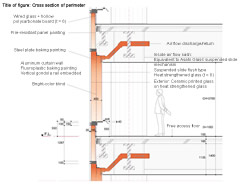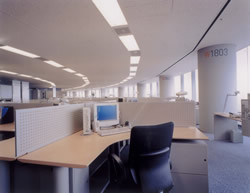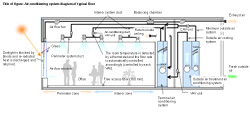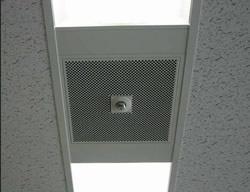Dentsu Head Office Building
Air flow window using ceramic printed glass
 |
|||
| Air flow window using ceramic printed glass | |||
 |
 |
 |
 |
The façade fully covered with ceramic printed glass not only accentuates landscapes but also reduces air conditioning loads significantly and conserves energy in combination with air flow windows. In addition, light that diffuses and passes through ceramic printed glass helps the use of daylight with less glare.
Task and ambient lighting system
 |
|||
| Inside view of office | |||
 |
 |
 |
 |
Two-system outside air supply system making use of cooling and humidification
 |
|||
| Air conditioning system diagram of typical floor | |||
 |
|||
As shown in the air conditioning system diagram of a typical floor, outside air is supplied to the terminal air conditioning system through two systems: one for minimum fresh-air intake and another for air cooling using outside air. This system
1) keeps the difference in temperature between supplied cold water and returned cold water large, 2) improves the humidification and cooling effect by water humidification in winter, and 3) controls the capacity of the terminal air conditioning systems.
Semi-personal air conditioning system
 |
|||
| Air outlet capable of adjusting flow rate separately in four different directions | |||
 |
 |
 |
|
To improve the productivity of the "intelligent production plant", we made the air conditioning system temperature as individually controllable as possible. We 1) segmented the VAV zone, 2) adopted wireless sensors, and 3) developed new air outlets that can adjust the flow rate separately in four different directions.
Previous Building |
 |
 |
 |
 |
 |
 Next Building Next Building |
CASBEE is a method for rating the environmental performance of buildings using Building Environmental Efficiency (BEE) as an indicator, which is based on the results of separate scores obtained for Q-1~Q-3 (Quality) and LR-1~LR-3 (Load Reduction).















 | Copyright © 2008 Institute for Building Environment and Energy Conservation, All Rights Reserved.
| Copyright © 2008 Institute for Building Environment and Energy Conservation, All Rights Reserved.